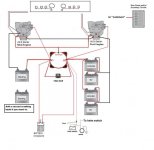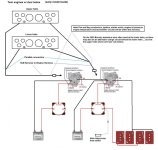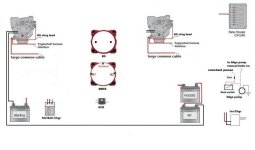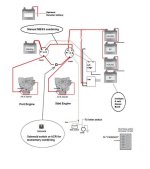Bill............................
My issues deals with a 1987 CC Catalina 381, with two mighty 454s. Issue is wiring.
It would appear that all house power is fed from a no #6 red off the circuit breaker on the port engine and a grey black off the starboard.
Red would certainly be a power conductor..... but the grey/black would likely be a Negative.
BTW, often will see the HLBB (house load batt bank) and House Loads taken from the Starboard side... not the Port side.
Either way..... we can discusss this.
They are connected to the 12v panel. As well on this panel are two engine switches which can turn off start power to the engines, but the power flow continues into the house requirements.
In my opinion, unless there is a special requirement........, House Loads should be "interruptible" when we leave our boats unattended.
We can always choose to leave the MBSS (main battery selector switch) ON if we need to.
Additionally the boat is equipped with two deep cycle btys,
This is a 381.... or 38 footer... correct?
I would think that your House Loads would demand more power than what two Deep Cycle batteries could provide.
See my ** below.
and it appears that neither is dedicated to start.
I would certainly want at least one dedicated cranking bank.
Btys are connected through two 1, 2, All, Off Perkos.
OK.... these are your MBSS's..... and Perko, IMO, is a poor choice. (small duty contacts/light contact spring pressure)
The questions are:
One: A red lead off the engine wiring through the breaker leads to #8 on the master wiring male plug. Where does that wire connect, at the bridge or where?
Almost impossible to answer without seeing a schematic.
Two: Does the engine really need the breaker in the first place.
If you are speaking of the typical Cole Hersee red button breaker............ Yes.
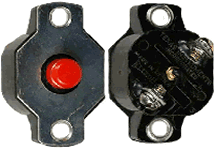
I ran a 427 for 37 years without such a device and as we all know there is scant difference between the 427 and 454. As well, why have engine cut offs other than the key switch or directly at the bty.
This has little to do with the engines, and has everything to do with circuit protection.
Third: Start/house. Obviously CC felt that they was no need for two banks, but being an anchor boater, it is imperative to have same. Given some help re the engine side I will move to build two banks, totally disconnected other than Alternator charging and house charging.
Any and all comments welcome.
There will be several ways to skin this cat.
But keep in mind, Bill.......... the furier dealer will tell you that some Cat Skinners will bring him a better pelt! 
Bill, not that you asked....... but if you are rolling up your sleeves and you are doing a major 12vdc electrical over-haul, I'd encourage you to bring a new dedicated circuit forward for your Nav gear, radios, etc, and keep these items from being powered via the OEM hull harness.
** I'd increase the capacity of your HLBB, so that usage between charging does not take the SOC below 50%.
Batteries taken much below 50% SOC, and if left there for any duration, will certainly see a shorter life span.
I'd also avoid using an Isolator. Isolators are old school technology by today's standards. We have ACR's and VSR's that do a much better job today.
************************************
Here are a few basic and simple systems that work fairly well.
I origianally put these together for other people, but hopefully thay can help you with your electrical needs.
First schematic:
This shows a single MBSS for a twin engine scenario and assumes that the HLBB is Starboard side.
The 500 Amp 7622 ACR will automatically combine banks for Stbd side cranking.
It will also allow the HLBB side to take advantage of the Port engine alternator charge rate while under way.
Note that the O/B Charger leads connect to the #1 and #2 terminals of the MBSS, and not to the battery terminals. (A pet peeve of mine!)
Also note that I show a new dedicated fuse/breaker panel for Accessories, etc.
Second schematic:
This shows 2 MBSS's, and 2 cranking banks.
I'm not showing the fuse/breaker panel for Accessories, ACR nor the O/B Charger connections, but these can be installed similar as in the first schematic.
Third schematic:
Here I've shown 2 MBSS's and a means for both "manual", "helm switch activated", and/or "automatic" combining.
This is very similar to how I have my own twin engine boat set up.
My boat is considerably smaller, but I believe that this can work for your 38.
Forth one shows some icons that you could shift around if you wanted to draw up a schematic.



